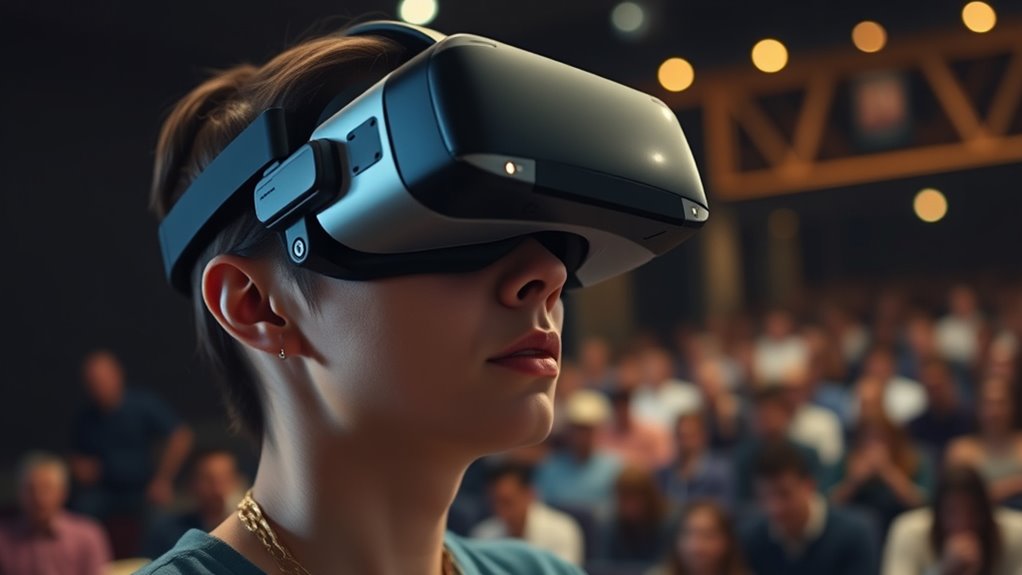VR exposure therapy can be a powerful tool to help you conquer your fear of public speaking. It creates immersive, safe environments where you can practice and build confidence gradually. By combining virtual scenarios with cognitive restructuring, you’ll learn to manage anxiety and challenge negative thoughts. While it’s not an instant fix, many find it effective for reducing stage fright and improving skills over time. Keep exploring to discover how this innovative approach might work for you.
Key Takeaways
- VR exposure therapy safely simulates speaking scenarios, helping reduce anxiety through repeated, controlled practice.
- Combining VR with cognitive restructuring addresses negative thoughts fueling fear, enhancing long-term confidence.
- While effective in decreasing fear, VR therapy is part of a comprehensive approach and may not completely cure stage fright alone.
- Consistent use of VR exposure builds skills and desensitizes triggers, leading to improved public speaking abilities over time.
- Long-term success depends on ongoing practice and integration with other therapeutic techniques, not a quick fix.

Fear of public speaking affects millions of people, often limiting personal and professional growth. It’s a common obstacle that can hinder your ability to communicate confidently in meetings, presentations, or social gatherings. Traditionally, overcoming this fear involved practice, therapy, or gradual exposure.
Fear of public speaking limits growth and confidence in meetings, presentations, and social events.
Now, with advancements in technology, virtual reality offers a new approach to tackling your anxiety head-on. VR creates immersive environments where you can simulate public speaking scenarios safely and comfortably. Instead of facing real audiences right away, you step into a virtual auditorium filled with attentive listeners, allowing you to practice and build confidence without the immediate pressure.
This immersive experience isn’t just about exposure; it’s also about cognitive restructuring. When you use virtual reality for exposure therapy, you can work with mental health professionals to identify and challenge negative thoughts that fuel your fear.
As you repeatedly practice in these virtual settings, you begin to reframe your perceptions about public speaking. For example, you might initially think, “I’ll mess up and embarrass myself,” but through guided sessions, you start to recognize these thoughts as exaggerated or unfounded. Cognitive restructuring helps you develop a more realistic and positive outlook, reducing anxiety over time.
VR exposure therapy is especially effective because it provides controlled, customizable scenarios. You can choose the level of difficulty, gradually increasing the complexity as you become more comfortable. This step-by-step approach guarantees you don’t feel overwhelmed and allows for consistent progress.
Additionally, virtual environments are designed to mimic real-life situations closely, making the transition to actual public speaking smoother. As you adapt to these virtual settings, your confidence grows, and your fear diminishes.
The beauty of virtual reality is that it offers a safe space to confront your fears repeatedly without judgment. With each session, you can refine your delivery, manage your nerves, and reinforce positive thoughts through cognitive restructuring.
Over time, this repeated exposure helps desensitize your anxiety triggers, making real-world speaking engagements feel less intimidating. My Dogs’ Names training shows that consistent, gradual exposure can significantly reduce anxiety levels. VR-based therapy isn’t a quick fix, but it provides a practical, engaging way to address your fear systematically.
If you’re committed to overcoming your stage fright, virtual reality could be a powerful tool to transform your public speaking skills and boost your confidence.
Frequently Asked Questions
How Long Does It Typically Take to See Results With VR Therapy?
You might start seeing progress after a few virtual sessions, but it varies based on your comfort level and consistency.
Typically, you’ll notice progress milestones within 3 to 6 weeks of regular practice. Staying committed to the therapy helps you build confidence gradually, and tracking these milestones keeps you motivated.
Are There Any Side Effects or Risks Associated With VR Exposure Therapy?
When considering VR exposure therapy, you might wonder about potential risks. You could experience virtual discomfort, like dizziness or eye strain, during sessions.
While generally safe, some people face simulation side effects such as nausea or headaches. These are usually temporary, but it’s important to discuss any concerns with your therapist.
Monitoring your reactions helps guarantee a safe, effective experience in overcoming fears through virtual environments.
Can VR Therapy Be Combined With Traditional Public Speaking Training?
You can definitely explore a blended approach by combining VR therapy with traditional public speaking training. Virtual integration allows you to simulate real scenarios, boosting your confidence.
While in-person coaching provides personalized feedback. This dual method maximizes benefits, helping you practice skills in a safe environment and then refine them with expert guidance.
Embracing this combination could considerably reduce your fears and improve your public speaking abilities more effectively.
Is VR Exposure Therapy Suitable for Extreme or Phobic Levels of Fear?
Imagine facing a storm; Virtual intensity varies, and if your phobia severity is like a hurricane, VR exposure therapy might be too gentle a breeze.
For extreme fears, this method isn’t always enough, as it may not match the depth of your anxiety. You might need more personalized or intensive treatments.
Always consult a mental health professional to determine if VR therapy suits your specific level of fear.
How Accessible and Affordable Is VR Therapy for Most Individuals?
VR therapy is becoming more accessible and affordable for many people. While the cost comparison to traditional therapy varies, prices have decreased as technology advances, making VR equipment more affordable.
However, technological limitations like hardware requirements and software availability can still pose barriers. Overall, if you’re interested, exploring options now could be worthwhile, especially since prices are dropping and accessibility is improving with ongoing technological progress.
Conclusion
Imagine stepping into a safe, simulated theater where your fears fade like shadows at dawn. VR exposure therapy offers a powerful tool to gently confront your fear of public speaking, building confidence one virtual audience at a time. While it may not be a quick fix, this journey can transform your anxiety into a steady, shining beacon. With patience and practice, you’ll find yourself ready to step onto the real stage with newfound courage.










